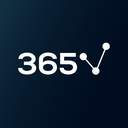Author’s Note: This article was originally published in 2021 and offers valuable insights and perspectives based on the available knowledge at the time of its publication. You can find the most up-to-date information in our new research, The Data Scientist Job Outlook in 2024.
About the Research
Every year, 365 Data Science publishes a study on 1,001 data scientist profiles. The information is collected from public LinkedIn profiles, assuming that the information posted on the social media platform is an unbiased estimator of their resume.
This research allows us to gain insights, with a reasonable degree of certainty, about who is a data scientist in 2021. We present only aggregate data to highlight important trends that can be useful to anyone who wants to break into the field, as well as to organizations looking to hire data scientists.
Executive Summary
- The typical data scientist profile delineated by our study: Identifies as male, has a Master’s degree, works comfortably with Python and SQL, has 6.2 years of prior working experience, works for a very large firm in the technology sector, has been on the job for about 1 year.
- The gender gap appears to be widening. The proportion of male to female data scientists in the 2021 version of the study is 82% (male) to 18% (female). In 2020, the ratio was 71% (male) to 29% (female), while in 2018 – 69% (men) to 31% (female).
- Currently, it takes around 7 years of prior working experience to become a data scientist.
- SQL surpassed R in popularity to claim the second position among coding languages ‘spoken’ by data scientists. Similarly to other studies, our research confirms that Python holds the top-most position.
- ‘Data scientist’ was the first job title for 22.6% of the individuals in our cohort. This goes to show that a considerable number of people begin directly as data scientists before gaining any other prior experience.
- In 96.5% of the cases, а university degree is required to break in the field. Our research shows that 76.7% of data scientists hold a Master’s (55%) or PhD (21.7%) degree. Additionally, those at a Bachelor’s level accounted for 19.8%.
- The tech industry increased its lead as the top data science employer. We found that 57.5% work in tech, with the financial sector coming in at a distant second with 19.8%
- Very big companies (with personnel of 10,000+) employ the most data scientists.
- An increasing number of data scientists (7.3%) list consulting or other types of employment in their profiles in parallel to their full-time role. Moreover, the number is potentially even higher, considering that not all side employments are listed on LinkedIn.
- Very few individuals (less than 2%) have stayed at the same job for more than 5 years.
- The median time spent on the job by a data scientist in our study was 1.7 years.
- The majority of data science professionals included in the study (56%) have changed jobs 2 or more times in the past 5 years.
- More than one-third of the data scientists in our cohort started their current job in the last 12 months.
In this article you will find:
- The Typical Data Scientist Profile
- Level of Education
- First Job
- Programming Skills
- Industry
- Own Business/Consulting
- Time Spent on the Job
- Job Changes Since 2017
The Typical Data Scientist Profile
One of the main goals of this research is to identify the typical profile of a ‘data scientist’. With this in mind, the findings that we present can give an idea about the overall trend in this profession at the time when the data was collected.
So, who is a data scientist in 2021?
To begin with, the typical data scientist identifies as male and holds a Master’s or a PhD degree. They work comfortably with Python and use SQL for managing data. Moreover, they have been in the workforce for a median of 6.2 years, have been working in a very large tech company for the past year, and have changed their job 2 or more times since 2017.
In recent years, companies have committed to diversifying their workforce by recruiting people from different backgrounds. At the same time, as a contrast to those pledges, the statistics show that data science continues to be largely a male-oriented field.
Level of Education
Based on our findings, we can safely conclude that a person needs formal university education to secure a job in the field. The statistics show that 76.7% of the individuals included in our study hold a Master’s (55%) or PhD (21.7%) degree. Another 19.8% have earned a Bachelor’s qualification.
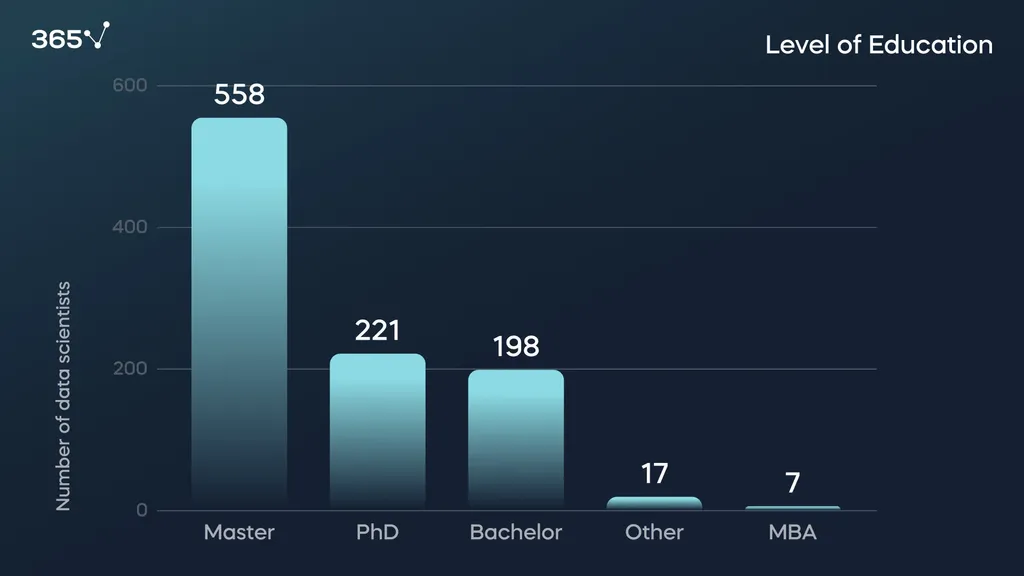
This assumption is in line with our findings from previous years. However, this year we observe one interesting trend: the proportion of data scientists with a Bachelor’s degree jumps from 12% in 2020 to almost 20% in 2021. With an ever-increasing access to online education platforms (including virtual university courses), companies will likely begin to prioritize technical skills over formal qualifications when selecting talent.
First Job
What was the first job of people who work as data scientists today? How did they start their career?
We haven’t answered these questions in previous versions of our research. However, this is a question our students ask very often, so it is about time we provide them with a proper answer, based on the numbers.
To begin with, almost a quarter of all data scientists were direct hires. They did not have any prior working experience before securing the ‘data scientist’ job title. In most instances, these are individuals with particularly strong technical skills (often with a PhD degree). In such cases, companies are willing to bet that, although they do not have any prior experience in a professional setting, they will be able to learn on the job and become productive fairly quickly.
A more gradual career path is to begin as an analyst or intern and climb the ladder toward becoming a data scientist. We can observe this in a bit more than a quarter of the cases.
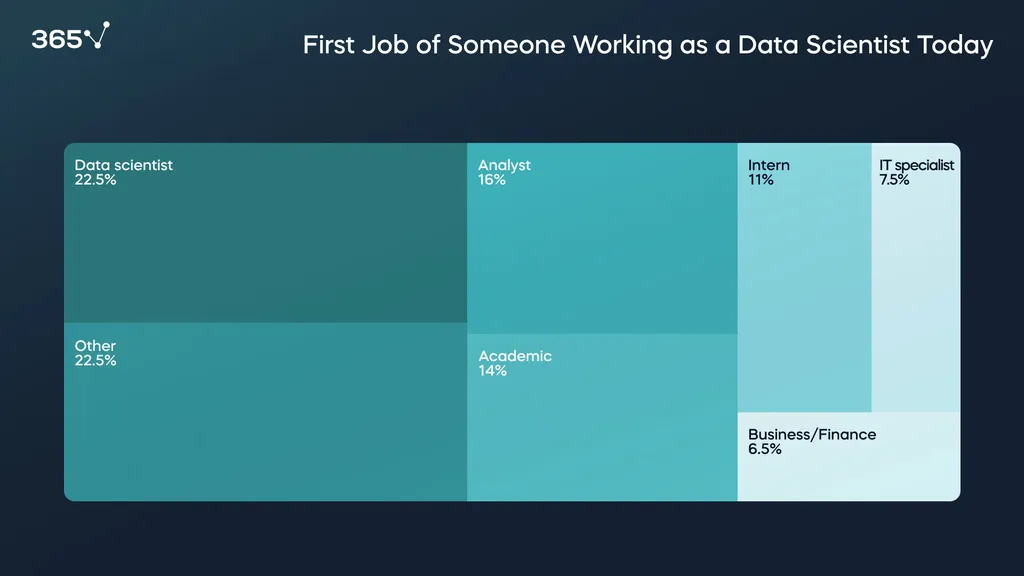
Transferring to a data scientist role from an academic background occurs often as well (14% of our cohort).
It is interesting to see that a large number of people (22.6%) started in a completely different field, but were able to requalify and secure a job in data science.
Programming Skills
Python’s popularity in the data science field has continued to grow in 2021, with almost 85% of the data scientists in our cohort using it. SQL is the other most popular tool, coming in at a very close second (82%). Moreover, a considerable number of users continue to use R (64%) which has lost some ground to Python over the last few years.
Overall, findings show that Python, SQL, and R are the 3 most popular coding languages data scientists ‘speak’.
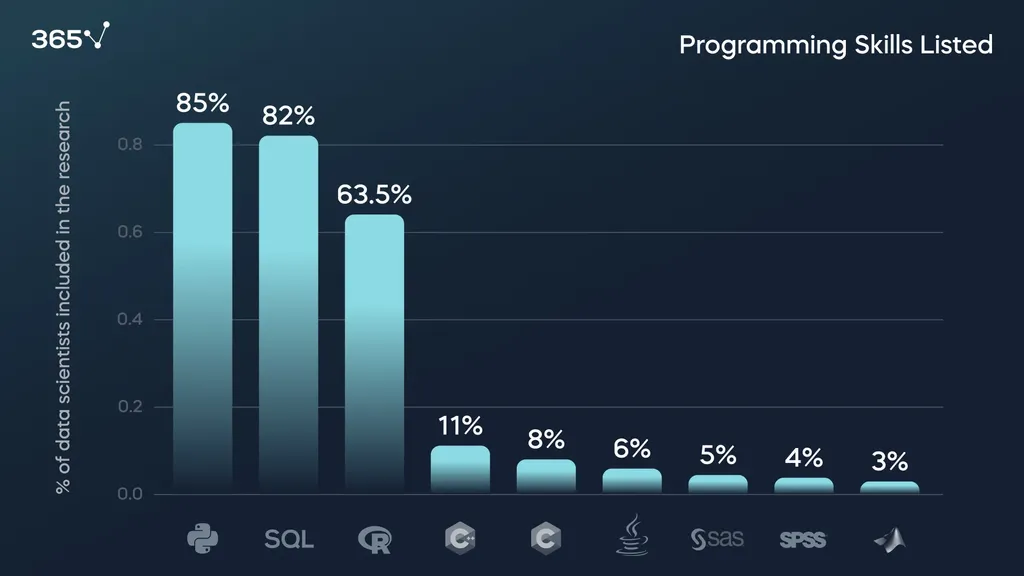
Industry
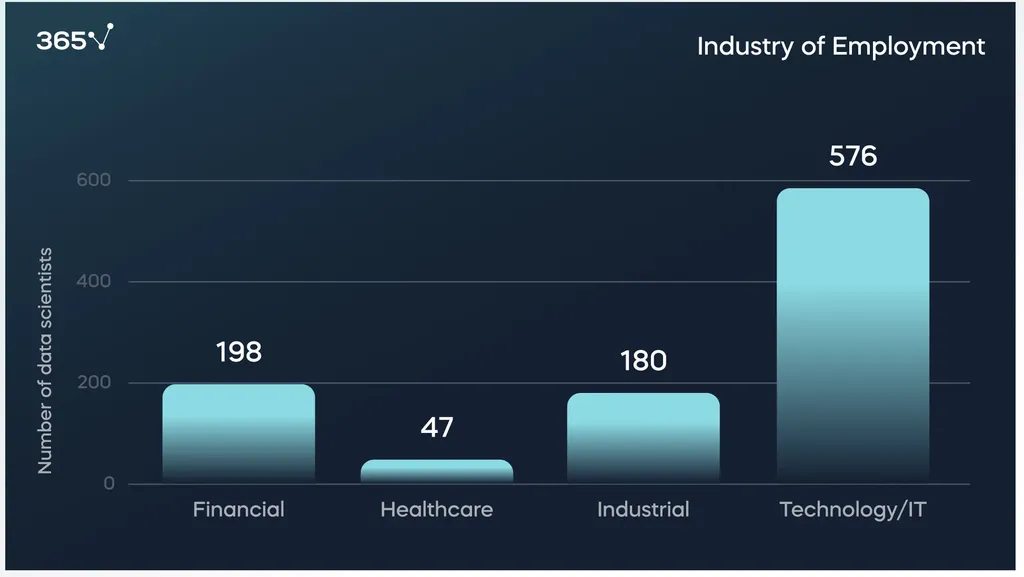
The tech industry is by far the biggest and most significant data science employer in 2021. In a ‘work from home’ environment, dominated by ecommerce websites, web platforms, and IT systems, it is only natural to see technology as the sector with highest demand for data scientists.
Own Business/Consulting
A very interesting finding is that 7.2% of the data scientist profiles we studied have listed an active side job or consulting work on LinkedIn. If we take into consideration the fact that many people provide such services outside of their full-time employment, but do not list them on LinkedIn, we can conclude that a growing number of data scientists are eager to apply their skills to earn additional income and face new professional challenges.
Time Spent on the Job
As far as we are aware, workforce mobility in the data science field is a topic that has not been studied in detail. However, the demand for skilled data scientists continues to be very high and we wanted to explore whether this impacts how much time data scientists spend on the job (before switching companies).
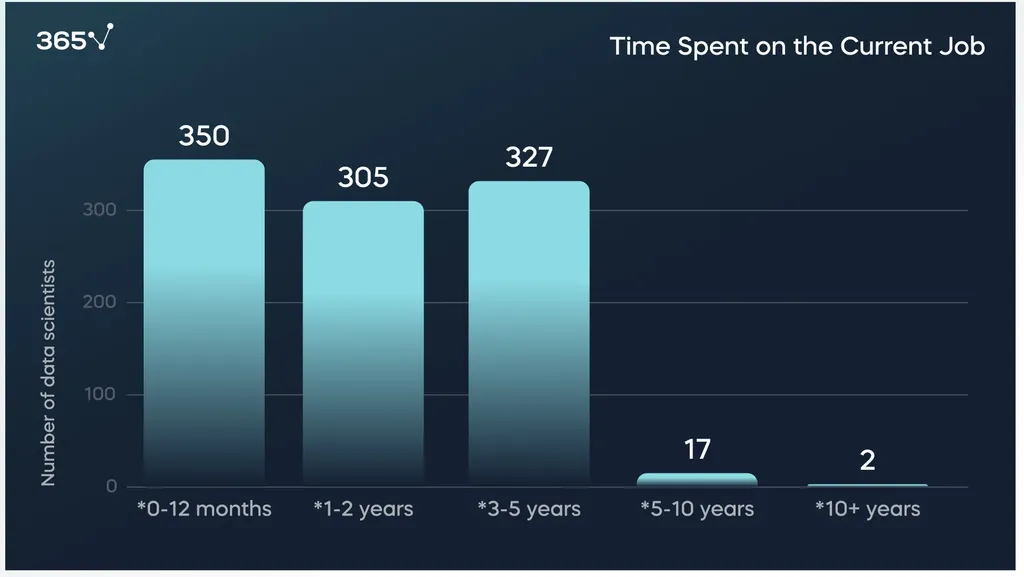
The numbers indicate that 35% of the data scientists in our study have been at their current jobs for less than a year. Additionally, another 30% have started their present employment within the last 2 years.
Unsurprisingly, those who were on the job for more than 5 years were less than 2%.
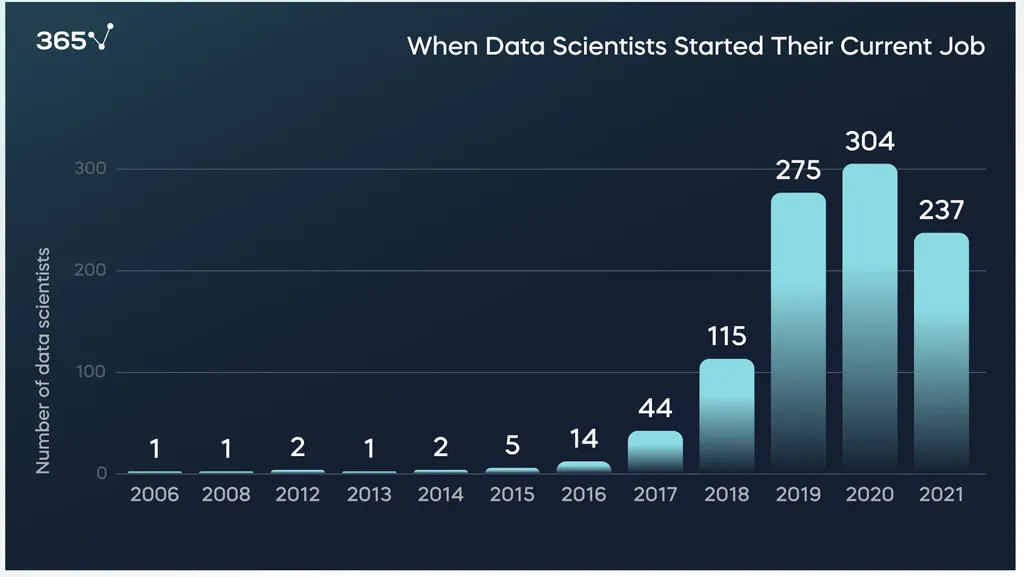
This chart shows when the individuals in our study stated working at their current job.
Job Changes Since 2017
More than half of the data scientists in our analysis (56%) have changed jobs 2 or more times in the past 5 years. Unfortunately, we don’t have the data to compare such mobility with other similar professions. However, considering the amount of training and onboarding necessary to bring someone to 100% productivity within a new position, the mobility we see poses the question whether this is efficient and effective for companies. The median time a data scientist spends on the job is 1.7 years, according to our study. Is, perhaps, Netflix’s strategy (shared by the firm’s CEO in his book ‘No Rules Rules’) to overpay employees in order to keep them for as long as possible a viable one, especially in regards to the costs involved with training a new person every 18 months or so?
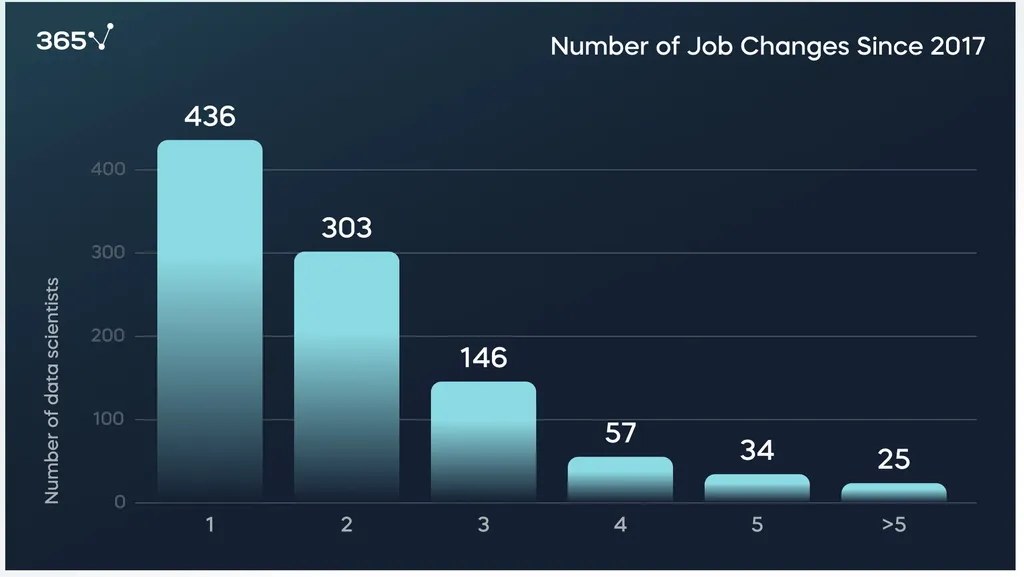
How we carried out the research
This research was carried out by our team. For the purposes of the analysis we collected data from 1,001 LinkedIn data scientist profiles. The rather large sample was formed by individuals working in four geographical areas: US (35%), UK (25%), EU (25%), and India (15%). Thus, the data was collected from data scientists with various backgrounds to limit bias.
